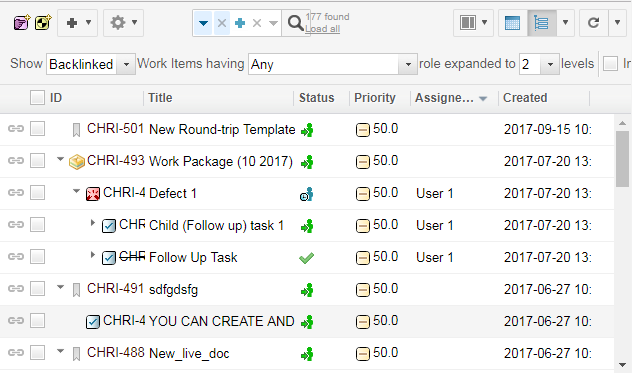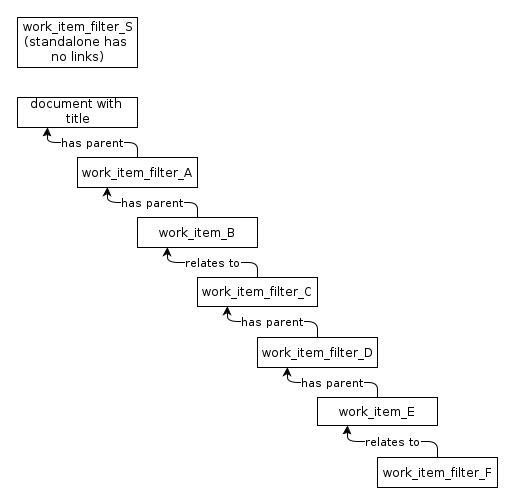 Tree view
Tree view
 Tree view is similar to the Table view, except the set of retrieved items is presented as a tree structure. Top level nodes are the items retrieved by the current query. If these items have other items linked to them, their nodes can be expanded to show the linked Work Items. If a child item has one or more items linked to it within the scope of the Depth query parameter, its node is expandable and the linked items appear as child nodes.
Tree view is similar to the Table view, except the set of retrieved items is presented as a tree structure. Top level nodes are the items retrieved by the current query. If these items have other items linked to them, their nodes can be expanded to show the linked Work Items. If a child item has one or more items linked to it within the scope of the Depth query parameter, its node is expandable and the linked items appear as child nodes.
In the  Tree view, the Visual Query Builder has several additional fields that enable you to specify the role(s) of linked items, the maximum number of link levels to search, the direction of linking, whether or not to include repository commits in the search results, and whether or not to filter all levels.
Tree view, the Visual Query Builder has several additional fields that enable you to specify the role(s) of linked items, the maximum number of link levels to search, the direction of linking, whether or not to include repository commits in the search results, and whether or not to filter all levels.

This view can require significant system resources to process, especially if the result set of the query is large and/or there are many linked Work Items. System administrators may impose a limit on the total number of items the query retrieves.
When opening the table view of a LiveDoc with outline numbering enabled, Outline Number appears as the first column unless already defined in the table configuration.
To hide the Outline Number column, customize the table in  Table view.
Table view.
View or hide duplicate search results in Tree view
Administrators can add or adjust the following property in the Configuration Properties section ( Administration
Administration 
![]() Configuration Properties) to control whether or not
Configuration Properties) to control whether or not  Tree search results include duplicate items. (Even if they're found in the nested tree of another item):
Tree search results include duplicate items. (Even if they're found in the nested tree of another item):
workitems.treeTable.removeDuplicateRoots=
Possible Values:
true (The default setting.)
Only the parent Work Items that match the filter criteria are displayed.
Child Work Items of the displayed Work Items that also match the search criteria are hidden by default but can be expanded manually by a user.
false
All Work Items that match the filter criteria are listed on the base level of the tree results.
(Any parent and child relationships that they have with each other are ignored.)
All Work Items can be expanded to reveal their descendants.
Note:This may result in some Work Items appearing multiple times in the list.
Use case example:
(Using title:work_item_filter_* as a query.)

If set to: workitems.treeTable.removeDuplicateRoots=true
The following Work Items will appear in the base  Tree search results.
Tree search results.
work_item_filter_S
work_item_filter_A
If set to: workitems.treeTable.removeDuplicateRoots=false
The following Work Items will appear in the base  Tree search results.
Tree search results.
work_item_filter_S
work_item_filter_A
work_item_filter_C
work_item_filter_D
work_item_filter_F